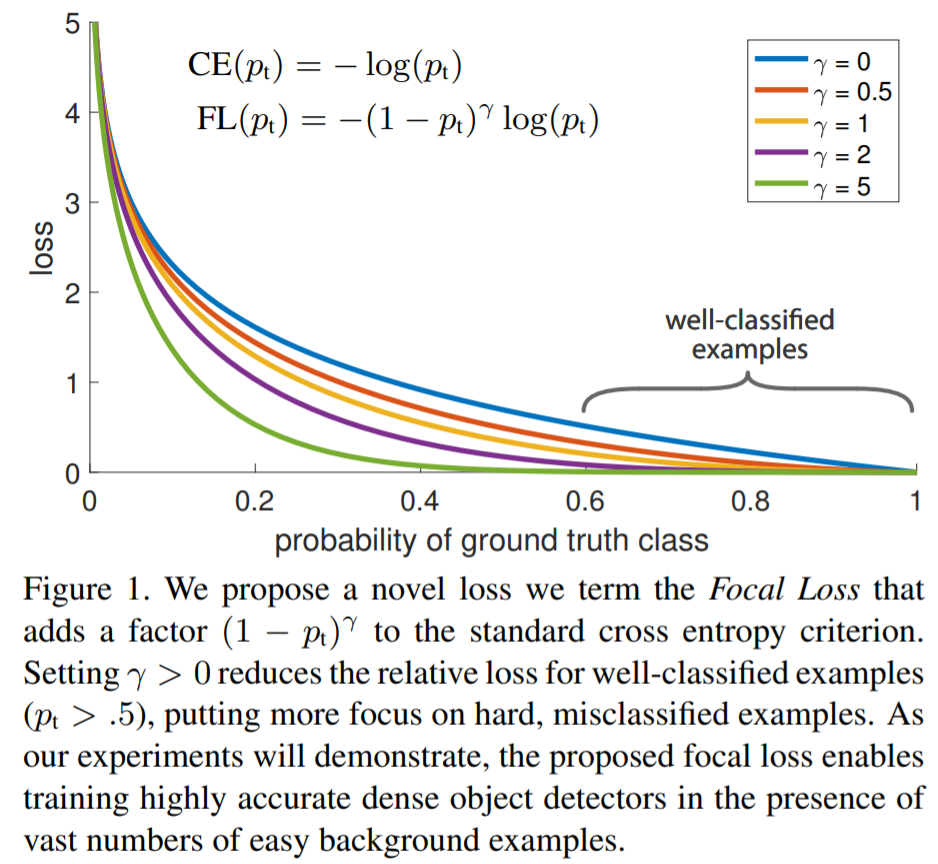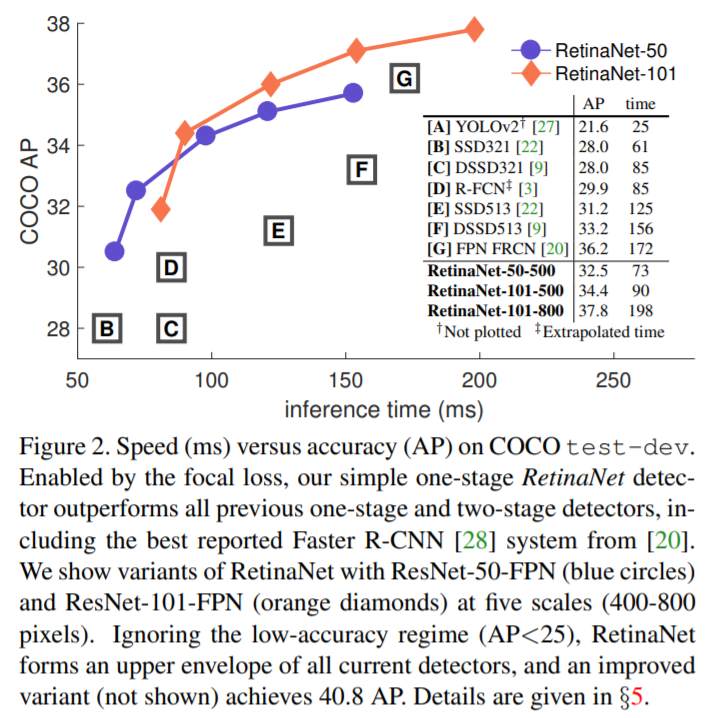[Paper Review] Focal Loss for Dense Object Detection paper
Focal Loss for Dense Object Detection
Lin, Tsung-Yi, et al. “Focal loss for dense object detection.” Proceedings of the IEEE international conference on computer vision. 2017.
Abstract
- detector
Two stage detector(ex RCNN framework)는 높은 정확도를 보임
One stage detector는 빠르고 간단하지만 two stage detector에 비해 정확도가 낮음
- One stage detector가 낮은 정확도를 보이는 주된 원인 : class imbalance (fore-ground/back-ground)
- class imbalance 문제를 해결하기 위해 cross entropy loss를 재구성 : novel Focal Loss 제안
많은 양의 easy examples을 down-weight 시키면서 적은 양의 hard examples에 더 집중하여 학습할 수 있도록 함
- loss를 test하기 위해 단순한 detector인 RetinaNet을 만들고 실험함
기존의 one stage detectors 만큼 빠르고 기존 SOTA인 two stage detector보다 성능은 더 좋음
Introduction
- Two-stage detectors : R-CNN framework
first stage : object locations 후보 집합을 생성 (sparse sampling)
second stage : CNN을 통해 각 후보들을 foreground class들 중 하나 또는 background class로 분류
two-stage detector는 COCO benchmark challenging에서 top accuracy를 달성
- One-stage detectors : YOLO and SSD
단순한 one-stage detetor로 비슷한 성능을 낼 수 있을지에 대한 연구
Object locations, scale 및 가로 세로 비율이 규칙적이고 밀도 높은 샘플링에 적용됨(dense sampling)
SOTA인 two-stage methods에 비해 10-40% 정확도(??)를 보이는 더 빠른 detectors
- two-stage detector의 성능을 따라잡는 최초의 one-stage detector 제시
class imbalance 문제를 해결하는 새로운 loss function 제안
- Two-stage methods에서의 class imbalance 해결법
R-CNN에서는 two-stage cascade와 sampling heuristics(??)를 통해 해결
Proposal stage(ex Selective search, EdgeBoxes, DeepMask, RPN)에서 background를 걸러내면서 object location candidate를 많이 줄임
Second classification stage에서는 fixed foreground-to-background ratio(1:3), online hard example mining(OHEM)와 같은 sampling heuristics를 수행
- One-stage methods의 문제점
이미지에서 너무 많은 양의 candidate를 규칙적으로 sampling함
중요한 정보를 걸러내지 못하고 너무 많은 양을 학습하면서 학습과정이 비효율적임
sampling heuristic과 유사한 것을 적용할 수는 있지만, 여전히 training 과정에 easy examples(ex background)이 너무 많아서 비효율적임
일반적으로 bootstrapping 또는 hard example mining과 같은 기법을 통해 해결
- Focal Loss
동적으로 scale이 조정되는 cross entropy loss이며, 여기서 scaling factor는 정확한 class에 대한 신뢰도가 증가함에 따라 0으로 감소
scaling factor는 training 과정에서 자동적으로 easy examples을 down-weight하고 model이 hard examples에 빠르게 집중할 수 있게 함
class imbalance 문제를 다루던 기존의 방식을 뛰어넘는 것을 실험을 통해 증명
- RetinaNet
Focal loss의 효과를 증명하기 위해 simple one-stage object detector를 만듦
ResNet-101-FPN backbone으로 구성한 것이 best model
## Focal Loss
-
One stage detection에서의 class imbalance 문제 해결을 위해 고안된 loss function
-
Cross Entropy Loss
- Balanced Cross Entropy
class imbalance 문제를 해결하기 위한 흔한 방법은 weighting factor를 도입시키는 것이며, 이때 weighting factor는 class 빈도와 반비례하여 설정되고 cross validation을 설정하기 위한 hyperparameter로 다루어짐
- Focal Loss Definition
balanced cross entropy에서 scaling factor는 positive(정답)/negative(오답) examples의 중요성에 균형을 이루지만, easy/hard examples을 구별할 수 없음
Focal loss : easy examples을 down-weight시키고 hard negatives에 대한 학습에 중점을 둠
Γ을 증가시킬수록 modulating factor의 영향력이 커짐 (실험에서 2로 설정하는 것이 제일 좋았음)
α-balanced variant of the focal loss
- Class Imbalance and Model Initialization
binary classification models은 기본적으로 class에 대한 확률값을 동일하게 초기화 (y=-1 일 확률 0.5, y=1 일 확률도 0.5)
하지만 사전에 class imbalabce에 대한 정보가 있으면 그에 맞게 초기화 시켜야 학습을 안정적으로 할 수 있음
- Class Imbalance and Two-stage Detectors
Two-stage detectors는 class imbalance 문제를 두가지 방식을 통해 해결함
1) a two-stage cascade : object proposal mechanism으로 방대한 양의 data set을 1000~2000개로 줄임
2) biased sampling : 일반적으로 positive와 negative의 비율(ex 1:3)이 minibatch 마다 동일하도록 구성
focal loss는 위와 같은 mechanisms을 loss function을 통해 one-stage detection에서 해결







Leave a comment